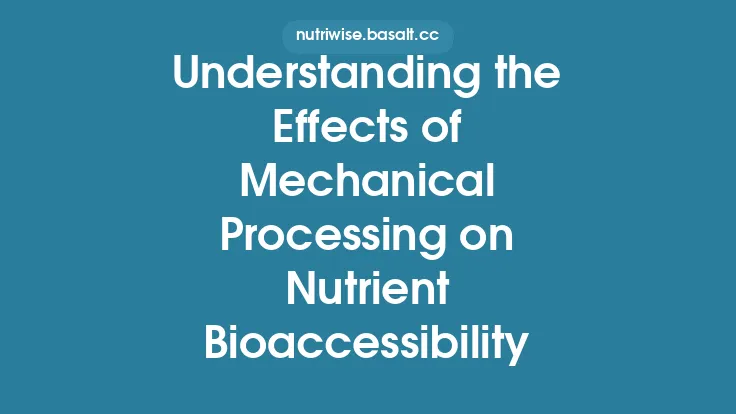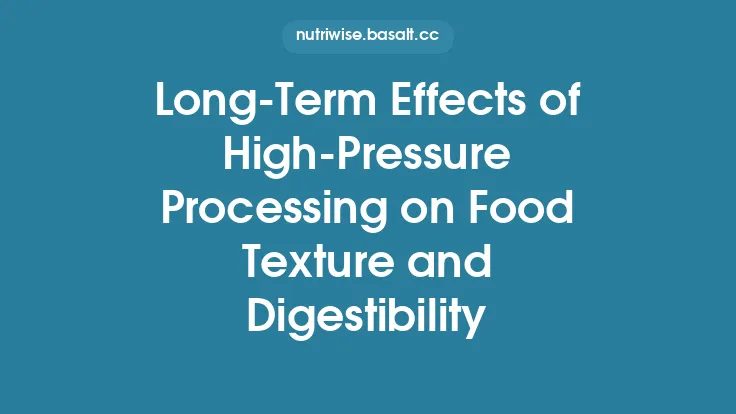Digestive enzymes are proteins that catalyze the breakdown of macronutrients into absorbable units. While their activity is often discussed in terms of pH, substrate specificity, or co‑factor requirements, temperature is an equally critical determinant of how efficiently these biocatalysts function. From the sizzling heat of a stovetop to the icy chill of a refrigerated salad, temperature influences enzyme conformation, reaction rates, and ultimately the nutritional outcome of the foods we eat. Understanding these thermal effects helps explain why cooking can both enhance and diminish nutrient availability, why raw or cold foods sometimes feel “harder to digest,” and how modern food‑preservation techniques impact the enzymatic landscape of our meals.
The Thermodynamic Basis of Enzyme Activity
Enzymes, like all proteins, exist in a delicate balance between ordered (native) and disordered (denatured) states. The Gibbs free energy (ΔG) of folding determines the stability of the native conformation. As temperature rises, thermal energy (kT) increases, providing the kinetic push needed to overcome activation barriers for substrate conversion. This relationship is captured by the Arrhenius equation, which predicts that reaction rates double for roughly every 10 °C increase in temperature—up to a point. Beyond the enzyme’s optimal temperature (T_opt), the added thermal energy begins to destabilize intramolecular forces (hydrogen bonds, hydrophobic interactions, ionic bridges), leading to partial unfolding and loss of catalytic geometry.
Each digestive enzyme has a characteristic T_opt that reflects its evolutionary origin. For instance, salivary α‑amylase, secreted at body temperature (≈37 °C), exhibits maximal activity near 40–45 °C, whereas pancreatic lipase, operating in the duodenum, peaks around 38–40 °C. These modest optimal ranges underscore why even modest deviations in temperature can have measurable effects on digestion.
Cooking: Heat‑Induced Denaturation and Nutrient Release
1. Inactivation of Endogenous Food Enzymes
Raw plant and animal tissues contain their own complement of enzymes—cellulases in vegetables, proteases in meat, and lipases in dairy. When foods are heated, these endogenous enzymes are rapidly denatured. The practical consequence is twofold:
- Reduced Pre‑Digestive Activity – In raw foods, native enzymes can begin breaking down macromolecules before they even reach the gastrointestinal tract, a phenomenon sometimes referred to as “pre‑digestion.” Cooking halts this process, shifting the burden entirely onto the host’s digestive enzymes.
- Preservation of Nutrient Integrity – Some endogenous enzymes, if left active, can degrade sensitive nutrients (e.g., polyphenol oxidases oxidizing phenolics). Heat inactivation preserves these compounds, indirectly supporting overall nutrient absorption.
2. Structural Modifications that Aid Enzyme Access
Heat also remodels the physical matrix of foods, making substrates more accessible to digestive enzymes:
- Protein Denaturation – Unfolded proteins expose peptide bonds that were previously buried within tertiary structures, allowing pepsin and trypsin to cleave more efficiently.
- Starch Gelatinization – At temperatures above 60–70 °C, the crystalline granules of starch absorb water and swell, converting insoluble amylose/amylopectin into a gelatinous matrix. This transition dramatically increases the surface area available to α‑amylase, accelerating carbohydrate digestion.
- Cell Wall Softening – Cooking disrupts pectin and hemicellulose cross‑links in plant cell walls, liberating trapped fibers and intracellular nutrients. The softened matrix permits greater diffusion of digestive enzymes into the food interior.
3. Over‑Cooking and Enzyme Destruction
While moderate heat improves digestibility, excessive temperatures can have adverse effects:
- Maillard Reactions – Prolonged heating at >150 °C initiates non‑enzymatic browning, forming advanced glycation end‑products (AGEs) that can impede enzyme binding and reduce amino acid bioavailability.
- Protein Cross‑Linking – High heat can cause irreversible covalent bonds (e.g., disulfide reshuffling) that render proteins resistant to proteolysis, a phenomenon observed in over‑cooked meats.
- Starch Retrogradation – Upon cooling, gelatinized starch can recrystallize into resistant starch type III, which is less susceptible to amylase. This illustrates that temperature effects are not unidirectional; the thermal history of a food matters.
Cold Foods: Temperature‑Dependent Enzyme Kinetics in the Gut
1. Slower Reaction Rates at Lower Temperatures
When a cold meal (e.g., chilled soup, ice cream) enters the stomach, the luminal temperature initially drops below the physiological norm. Enzyme kinetics are temperature‑sensitive, so the catalytic turnover (k_cat) of gastric pepsin, pancreatic amylase, and intestinal lipase is temporarily reduced. The result is a perceptible delay in the onset of digestion, often experienced as a “heavier” feeling after consuming very cold foods.
2. Thermally Induced Gastric Motility Adjustments
The gastrointestinal tract possesses intrinsic thermoregulatory mechanisms. Cold ingestion triggers a mild sympathetic response that can transiently slow gastric emptying, allowing the stomach to re‑warm its contents. This delay provides additional time for enzymes to act once the temperature normalizes, partially compensating for the initial kinetic slowdown.
3. Preservation of Heat‑Sensitive Nutrients
Cold storage preserves labile nutrients (e.g., certain vitamins, antioxidants) that might otherwise degrade during cooking. While the enzymes that would normally degrade these compounds are less active at low temperatures, the host’s digestive enzymes remain capable of extracting the nutrients once the food reaches body temperature. Thus, cold foods can offer a nutritional advantage when the balance between enzyme activity and nutrient stability is considered.
Enzyme Stability Across Common Food‑Processing Temperatures
| Processing Method | Typical Temperature Range | Effect on Digestive Enzyme Activity (in food) | Practical Implications |
|---|---|---|---|
| Blanching (vegetables) | 80–100 °C, 1–5 min | Near‑complete inactivation of endogenous amylases, peroxidases | Improves texture, reduces oxidative loss |
| Steaming | 100 °C (steam) | Denatures proteins, gelatinizes starch without excessive Maillard browning | Enhances digestibility while preserving color |
| Boiling | 100 °C, 10–30 min | Full denaturation of most food enzymes; possible leaching of water‑soluble nutrients | Good for legumes; may reduce water‑soluble vitamins |
| Roasting/Baking | 150–220 °C | Strong protein cross‑linking, Maillard product formation; starch gelatinization followed by retrogradation on cooling | Increases flavor, may reduce protein digestibility if over‑done |
| Frying | 160–190 °C | Rapid surface protein denaturation, formation of crust; high lipid oxidation | Quick cooking, but can create resistant protein structures |
| Freezing | –18 °C to –40 °C | Minimal immediate effect on enzyme activity; ice crystal formation can disrupt cell walls, exposing substrates upon thawing | Preserves nutrients; thawed foods may be more readily digested |
| Refrigeration | 0–4 °C | Enzyme activity slowed dramatically; some psychrotrophic enzymes (e.g., certain bacterial proteases) remain active | Extends shelf life; may lead to subtle texture changes over time |
Practical Recommendations for Optimizing Digestive Enzyme Performance
- Match Cooking Method to Food Matrix
- Starchy vegetables (potatoes, carrots) benefit from boiling or steaming to achieve gelatinization without excessive Maillard reactions.
- Protein‑rich foods (meat, legumes) are best cooked at moderate temperatures (150–180 °C) for sufficient denaturation while avoiding over‑cross‑linking.
- Consider Sequential Temperature Treatments
- A brief high‑heat sear followed by a lower‑temperature braise can create a flavorful crust (high‑temp Maillard) while allowing the interior to cook gently, preserving enzyme‑friendly textures.
- Utilize Controlled Cooling
- After cooking, rapid cooling (e.g., ice‑water bath) can lock in the gelatinized state of starches, reducing retrogradation. If a cooler texture is desired (e.g., for salads), this step helps maintain digestibility.
- Mind the Timing of Cold Food Consumption
- Allow cold dishes to sit at room temperature for a few minutes before eating, especially for protein‑heavy meals, to let the temperature rise and enzyme kinetics normalize.
- Leverage Freezing for Enzyme‑Rich Foods
- Freezing fruits and vegetables preserves their native enzymes, which can be beneficial when the food is later consumed raw (e.g., smoothies). However, thawed foods should be cooked promptly to prevent microbial enzyme activity.
Future Directions: Engineering Thermal Resilience
Research into thermostable variants of human digestive enzymes is ongoing, driven by the desire to develop enzyme supplements that retain activity across a broader temperature spectrum. By borrowing stability motifs from extremophilic microorganisms (e.g., increased proline content, additional disulfide bridges), scientists aim to create formulations that remain active in both hot soups and chilled smoothies, offering consistent digestive support regardless of meal temperature.
Moreover, novel food‑processing technologies such as high‑pressure cooking (HPC) and sous‑vide (precise low‑temperature water bath) allow for controlled thermal exposure that maximizes nutrient release while minimizing enzyme denaturation. These methods illustrate how a nuanced understanding of temperature effects can be harnessed to improve both culinary quality and digestive efficiency.
Concluding Perspective
Temperature is a master regulator of digestive enzyme function, dictating whether enzymes in food are active, denatured, or rendered inaccessible. Cooking harnesses heat to break down structural barriers, making nutrients more amenable to the body’s own enzymatic arsenal, yet excessive heat can create resistant complexes that impede digestion. Conversely, cold foods temporarily slow enzymatic reactions but preserve heat‑sensitive nutrients and maintain the integrity of endogenous enzymes until they are needed. By appreciating the thermodynamic principles that underlie enzyme stability and by applying thoughtful cooking and storage practices, we can optimize the nutritional payoff of every meal, ensuring that the enzymes—both in our bodies and in our foods—operate at their best.





